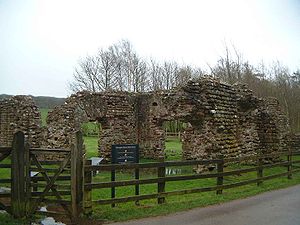
Ravenglass Roman Bath House
Encyclopedia

Ancient Rome
Ancient Rome was a thriving civilization that grew on the Italian Peninsula as early as the 8th century BC. Located along the Mediterranean Sea and centered on the city of Rome, it expanded to one of the largest empires in the ancient world....
fort and naval base
Naval base
A naval base is a military base, where warships and naval ships are deployed when they have no mission at sea or want to restock. Usually ships may also perform some minor repairs. Some naval bases are temporary homes to aircraft that usually stay on the ships but are undergoing maintenance while...
. Described by Matthew Hyde in his update to the Pevsner Guide
Pevsner Architectural Guides
The Pevsner Architectural Guides are a series of guide books to the architecture of the British Isles. Begun in the 1940s by art historian Sir Nikolaus Pevsner, the 46 volumes of the Buildings of England series were published between 1951 and 1975. The series was then extended to Scotland and...
to Cumbria as "an astonishing survival", the still standing walls are 13 ft (4 m) high. Known to the Romans as Glannoventa, the bath house is located to the north east of the fort.
Excavations were carried out at the bath house in 1881. The remaining fragment appears to be the west end of a building which was about 12 metres wide and about 27 metres long (see plan). It consisted of a suite of rooms arranged in a double sequence along the building. The entrance and changing area (apodyterium) contains niches, perhaps originally for statues. The use of the other rooms is not known, but there would have been a range of warm rooms, a hot bath and a cold plunge. Remains of the hypocaust
Hypocaust
A hypocaust was an ancient Roman system of underfloor heating, used to heat houses with hot air. The word derives from the Ancient Greek hypo meaning "under" and caust-, meaning "burnt"...
heating system were uncovered in 1881 but they have since been reburied.
The walls bear patches of the internal rendering, in dull red and white cement, and traces of the splayed window openings remain. The north and south walls have external buttresses which were probably intended to take the weight of a vaulted roof.
Roman Fort
The fort's defences were originally of turf and timber, although in the early 3rd century a stone wall was constructed. The fort appears to have been occupied continuously from AD 130 until the end of the 4th century.Today the bath house is in state care, and is managed by English Heritage
English Heritage
English Heritage . is an executive non-departmental public body of the British Government sponsored by the Department for Culture, Media and Sport...
. Access is via a private road which runs adjacent to a nearby caravan park. The ditch of the fort is also visible, but this is on private land and is bisected by the railway tracks of the Cumbrian Coast Line
Cumbrian Coast Line
The Cumbrian Coast Line is a rail route in North West England, running from Carlisle to Barrow-in-Furness via Workington and Whitehaven. The line forms part of Network Rail route NW 4033, which continues via Ulverston and Grange-over-Sands to Carnforth, where it connects with the West Coast Main...
.

